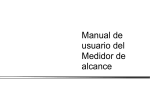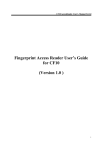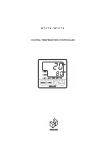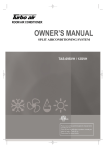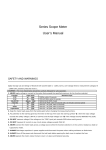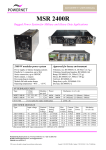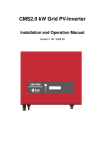Download Scope Meter - PCE Instruments
Transcript
Scope Meter PCE –OC 2 User’s Manual SAFETY AND WARNINGS The following safety precautions apply to both operating and maintenance personnel and must be observed during all phases of operation, service, and repair of this instrument. Before applying power, follow the installation instructions and become familiar with the operating instructions for this instrument. The meter Digital Storage USB and design of IEC1010 with wavelet table 1 - safety norms, over-voltage electric measurement category III - 1000V CAT, Pollution protection level: 1. Caution: The rules listed below should be carefully followed for safe operation. 1. NEVER apply voltage or current to the meter that exceeds the specified maximum for the function selected. Function Input Jacks Maximum Input V DC V/ΩđCOM 1000Vp, within 10 seconds V AC V/ΩđCOM 700V AC RMS, within 10 seconds mA AC/ DC 400mAđCOM A AC/ DC 20AđCOM 500mA DC/AC RMS, Fused 20A DC/AC RMS, within 30 seconds with a 15 minutes cool down period 1 Ω V/ΩđCOM 250V DC + AC peak, within 10 seconds Diode V/ΩđCOM 250V DC + AC peak, within 10 seconds Capacitance V/ΩđCOM 250V DC + AC peak, within 10 seconds 2. Keep the meter leads away from the testing point when changing the measuring functions. 3. Pay attention to the warning given by the meter at the top of the LCD: the warning symbol “ ”, when the input voltage exceeds the safety voltage ( 36V DC or 25V AC) and the high voltage icon “ ” if the voltage reaches 600V(DC+AC peak). 4. DO NOT measure voltage if the voltage on the "COM" input jack exceeds 500V above earth ground. 5. DO NOT measure AC current on any circuit whose voltage exceeds 250V AC. 6. NEVER connect the meter leads across a voltage source while the function selection is in the current, resistance, diode or capacitance mode. 7. ALWAYS discharge capacitors in power supplies and disconnect the power when making resistance or diode tests. 8. ALWAYS turn off the power and disconnect the test leads before opening the back cover to replace the fuse. 9. NEVER operate the meter unless the back cover is in place and fastened securely. 2 The International Safety Symbols This symbol, adjacent to another symbol or terminal, indicates the user must refer to the manual for further information. This symbol adjacent to one or more terminals identifies them as being associated with ranges that may, in normal use, be subjected to particularly hazardous voltages. For maximum safety, the test leads should not be handled when these terminals are energized. Double Insulation (Protection Class) This symbol advises the user that the terminal(s) so marked must not be connected to a circuit point at which the voltage, with respect to earth ground, exceeds (in this case) 500 VAC or VDC. The CAUTION symbol indicated a potentially hazardous situation which, if not avoided, may result in minor or CAUTION WARNING moderate injury The WARNING symbol indicates a potentially hazardous situation which, if not avoided, could result in serious injury or death 3 CONTENT SAFETY AND WARNINGS .................................................................................................................................................. ... 1 INTRODUCTION ... ................................................................................................................................................................... . 8 Features... ...................................................................................................................................................................... .8 Overview of the Keys ... ................................................................................................................................................ ..9 BASIC OPERATION ... ........................................................................................................................................................... . 10 Power On and Off ... ................................................................................................................................... .10 Auto Power Off... ...................................................................................................................................... ...10 Backlight ... ............................................................................................................................................... ...10 Battery Level Indicator ............................................................................................................................. ...11 Battery Charge ......................................................................................................................................... ...11 The Use of AC Adapter ... ......................................................................................................................... ..12 Reset the Instrument... ............................................................................................................................. ...13 4 DMM OPERATION ... ............................................................................................................................................................. . 14 Select DMM Mode ... ................................................................................................................................................... .14 Basic Displays of the DMM Mode ... .......................................................................................................................... ..14 Select the Function of DMM ... .................................................................................................................................... .14 Auto/Manual Range Selection ... ................................................................................................................................. .15 Data Hold ... ............................................................................................................................................................... ...16 AC and DC Voltage ... ................................................................................................................................................ ..17 dB Display... ................................................................................................................................................................ ..18 AC and DC Current (400mA, 20A) ... ........................................................................................................................ ...19 Frequency Counter and Duty Cycle... ........................................................................................................................ ..20 Resistance and Conductivity ... ................................................................................................................................. ...21 Continuity ... ............................................................................................................................................................... ...22 Diode Test ... ................................................................................................................................................................ .22 Capacitance ... ............................................................................................................................................................ ..23 Relative Mode ... ......................................................................................................................................................... ..24 Peak Hold (P-H) Mode................................................................................................................................................. .25 Communication in DMM mode ... .............................................................................................................................. ...26 Save and Recall the Data of Measurement ... ........................................................................................................... ..27 Communication in DMM database... ........................................................................................................................... .28 5 DSO OPERATION .............................................................................................................................................................. ... 30 Select DSO Mode ... ................................................................................................................................................... ..30 Basic Displays of the DSO Mode... ........................................................................................................................... ...30 Function Keys and Main Menu ... .............................................................................................................................. ...31 Input Coupling Select................................................................................................................................................. ...32 Time Base Control ... ................................................................................................................................................... .32 Horizontal Position Adjustment ... ............................................................................................................................. ...37 Vertical Scale Adjustment ... ....................................................................................................................................... ..38 Vertical Position Adjustment ... .................................................................................................................................... .38 Trigger Control ... ......................................................................................................................................................... .40 Trigger Level Adjustment ... ....................................................................................................................................... ...40 About the Trigger Modes ... ....................................................................................................................................... ...41 Indication of trigger Status ... ....................................................................................................................................... .42 Capturing a Single-Shot Signal... .............................................................................................................................. ...42 Cursor Readout Function... ....................................................................................................................................... ...38 Auto Measurement ... ................................................................................................................................................ ...40 AUTOSET Function ... ................................................................................................................................................ ..40 Waveform Freeze ... ................................................................................................................................................... ..41 Communication in DSO mode ... ................................................................................................................................. .43 Save and Recall the Waveforms ... ........................................................................................................................... ...44 6 Communication in DSO database ... ........................................................................................................................... .47 SETUP AND ZERO-VOLT CALIBRATION .................................................................................................................... ... 48 TECHNICAL SPECIFICATIONS ... ..................................................................................................................................... . 51 General Specifications ... ............................................................................................................................................. .51 Digital Storage Oscilloscope ... .................................................................................................................................... .52 Digital Multimeter ....................................................................................................................................................... ...53 Display Symbols ... ....................................................................................................................................................... .55 MAINTENANCE ... ................................................................................................................................................................. ... 62 TROUBLESHOOTING ... ....................................................................................................................................................... . 65 7 INTRODUCTION Features • Combination of a 4000 count auto-range True RMS DMM and a handheld Digital Storage Oscilloscope at the size and the cost of a multimeter. • DMM functions include True RMS AC/DC voltage and current, resistance, capacitance, frequency, duty cycle, dBm, diode and continuity tests • Full auto set up for volt/div and time/div of DSO • DSO Trigger mode: Auto/normal/single • DSO Auto measure: Vpp, Vavg, Vrms, dBm • DSO Cursor readout: dV, dt, 1/dt (frequency) • Screen hold function • Save and recall up to 100 waveform and data • High contrast FSTN LCD with white LED backlight • Auto power off in 5~60min or continuous on 8 • Inner Polymer Li-Ion Battery with AC adapter • Isolated USB/RS232 interface with PC Overview of the Keys Keys Name Function PC communications interface control and system Settings/Zero PC adjustment of options Turns the instrument of or off. F1 F2 F3 F4 Activates the backlight, toggles the backlight ON/OFF. PC MODE MODE Toggles the operation mode of DMM/DSO F1 ~ F4 Perform the function indicated on the LCD display. 9 DMM selection function (Voltage/Resistance/Hige/Diode/Capacitance/Current) / ADP FUNCS. mode (Temperature/Transistor/Crystals/External Clamp Head Measuring), DSO automatic measurement project selection (Vp, Vavg, Vrms - p, dBm) AUTO / RANGE DMM automatically or manually choose range, automatic Settings, DSO zero self-adjustment Choose the DC/AC measurement DMM DSO or the input DC/AC/ HOLD/MEM (on the rear of the instrument) RESET coupling Maintain current measurement data or entering/exit data storage management functions Resets the system. 10 BASIC OPERATION Power On and Off Pressing and holding the Power switch seconds again will turn the power off. for 2 seconds will turn the instrument on. Pressing and holding this button for 2 Caution: Before turning off the power, please keep the probe away from the testing point. • Always remember to turn off the power in time after using the instrument.. Auto Power Off If the meter idles for a certain time, the instrument will automatically shut off. The time of AUTO POWER OFF can be adjusted in the SETUP function. When AC power supply is used, this function will be suspended automatically. To protect the rechargeable battery from over discharge, the instrument will automatic shut-down when the battery runs out. 11 Backlight Backlighting improves the LCD effect in dark environment. Extended use of backlighting will reduce the battery life. This meter has 3 levels of brightness for users to choose. 1. Press the backlight control button to turn on the backlight and the luminance will be getting higher one step per 0.5 seconds. If the button released at any bright level, the backlight will keep this luminance. 2. After a certain time, the backlight will shut off automatically. With the SETUP function the time of backlight auto off can be changed. 3. To turn the backlight off manually, press this button again. Battery Level Indicator Battery level If the Scopemeter runs with the inner battery, there is an icon on the upper right corner of LCD to indicate the battery level. User can estimate the left time of the battery with this indicator. 12 Battery Charge The inner polymer Li-Ion battery will be automatically recharged when the AC Adapter is connected. If the AC Adapter is connected when the meter is off, it will enter charge Icon of AC adapter function directly and display the progress of charging. When the rate of progress reaches 100%, the charging is done. No matter the charging is finished or not, when the AC adapter is cut off, the meter will turn off automatically. Level of charging There are only two buttons can be used in charging function, the power button, to turn on the meter, and the backlight button, to control the backlight. If the AC Adapter is connected when the meter is on, power form the AC adapter will not only charges the battery but also keeps the meter operating. The Use of AC Adapter The major function of AC adapter is changing the inner battery of the meter, but it can also be the power supplier of the meter. 13 Under this condition, the power in the battery is not consumed. The AC adapter can be used whether the meter is on or off. If the AC adapter connected to the Icon of AC adapter instrument, when the instrument is on, it will keep the meter operation and the only difference is the battery level indicator becomes the icon of AC adapter. If the meter is off, when the AC adapter connected, the meter will enter charge function. If turn on the meter at charge function, the meter will operate as usual. Turning off the meter, when using AC adapter to supply power, the meter will return to charge function until the AC adapter is unconnected. So, to make the meter turned off completely, the AC adapter would be cut off. Caution: Using AC adapter for power supply may decrease safety performance of the instrument and introduce more electromagnetic disturbance. So, operating the instrument with the inner lithium battery is recommended for better Security and the best performance. Warning: DO NOT measure Volts over 250VAC or 360VDC with the power supply of AC adapter. That may cause the instrument damage permanently, even endanger user’s safety. 14 Reset the Instrument In case of unusual behaviors of the keypad or the display, it is possible to reactivate the instrument by using the RESET function. Press the sunken RESET push button at the rear of the instrument and it will subsequently return to the manufacturer-programmed setup. Caution: When you press the RESET push button, DO NOT use a sharp tool! 15


















